The most common is the second form of the disease - inflammation of the middle ear - and it is most often implied by doctors, putting the child or adult diagnosed as "otitis."Treatment of the disease is always carried out by an otolaryngologist, prescribing several drugs: an antibiotic( read what antibiotics are drunk with otitis), vasoconstrictor drops in the nose, drops in the ear. If necessary, anti-inflammatory hormonal drops, also buried in the auditory can be used.
Contents
- 1 Causes of
- 2 Treatment of
- 2.1 For adults
- 2.2 For children
- 2.3 Procedure for instillation: sequence of actions
Causes of
What can cause inflammation of the middle ear? The disease is not independent - it always comes as a complication of another viral or bacterial disease: influenza, acute respiratory viral infection, acute rhinitis. Otitis often appears due to a protracted rhinitis: an increased accumulation of mucus in the nose and a constant sniffing give an increased strain on the organs of hearing.
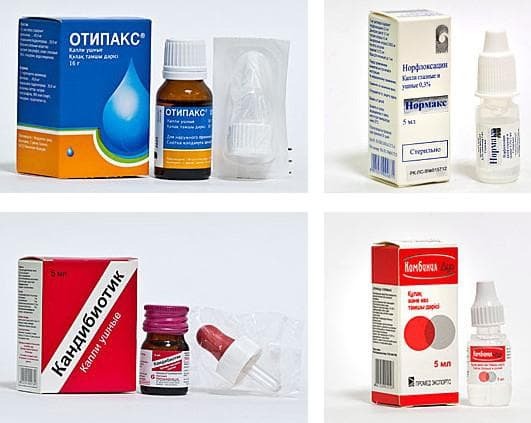
Infection of the ear and the appearance of the disease can also trigger the following factors:
- ingress of water into the ear( especially this is important when visiting the pool in the cold season);
- inaccurate and aggressive hygiene of the auricles and passages, which provoked trauma;
- draft;
- features anatomy of the ear.
To avoid the disease, it is necessary to keep your ears warm during cold weather, you must wear a hat in winter, and after water procedures do not go out with a wet head.

Is it possible to treat chronic bronchitis with folk remedies in adults?
Possible causes of sore throat: http: //prolor.ru/g/ bolezni-g /pershenie/ v-gorle-prichiny-i-lechenie.html.
Find out what to do if your child has an allergic cough.
Treatment of
What properties should an ear drop have? First of all, they require pain relief and local antiseptic action.
For adults
There are also drops with antibacterial effect: they help fight inflammation-causing bacteria directly in the source of infection. Let us consider them in more detail. Drop Names:
- Neladex. This is a combined preparation that can be used to treat ears and eyes. It is approved for use in patients with 12 years of age, contraindicated in pregnancy and lactation. The drug has a pronounced anti-allergic, anti-inflammatory and antibacterial action. Before burying Neladex in your ear, you should warm it up slightly, holding the bottle in your hands. Frequency of application - 3-4 times a day for 2-3 drops. The duration of treatment should be determined by the doctor. Contraindications - trauma and infectious lesions of the tympanic membrane, viral and fungal diseases of the ears.
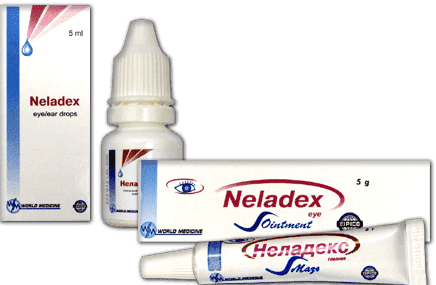
- Normax. It is authorized for patients from 12 years of age. A medicine with an antimicrobial effect, which, like Neladex, can be buried not only in the ears, but also in the eyes. It is well tolerated by patients and very rarely causes side effects. Apply Normaks should be 4-6 times a day for 2-3 drops. Contraindications - individual intolerance of components. When pregnancy is better not to use.

- Sofradex .Strong corticosteroid( hormone-containing) medicine, which can be used only with the permission of a doctor. He also sets the duration of administration and dosage, which is calculated based on the weight of the patient. The pronounced analgesic effect can cause the patient to instill drops more often than is necessary, but in no case can this be done: an overdose can cause a serious allergic reaction in the form of edema, itching and redness.
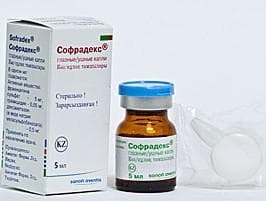
In the treatment it is necessary to adhere to the regimen prescribed by the attending physician. You may also need information about the treatment of acute catarrhal otitis in adults.
For children
Children's medicines differ from adults by the dosage of active substances and a higher degree of their purification. They are divided into four varieties: antibacterial, antifungal, corticosteroid and acid. Determine which of them is best suited in a particular case, can only the doctor after a thorough examination. List of drops for the treatment of otitis in children:
- Cypropharm .These are drops from otitis with an antibiotic. Contains ciprofloxacin - a broad-spectrum antibiotic. Recommended for use from 12 months. The drug can not be buried in a cold form - before installation it must be warmed to 18-22 ºC.Children are usually assigned 3 drops in both ear canals every 12 hours. The duration of treatment is 5-10 days.

- Otypaks .Anesthetics and anti-inflammatory drops, which can be used even in infants. Do not contain hormones and antibiotics, so the only contraindications - violation of the integrity of the tympanic membrane and an allergic reaction to the components. To fix the effect, doctors recommend to be treated with Otipaks from 7 to 10 days, the daily norm - 2-3 times 4 drops in each ear. Use the drug is necessary within 6 months from the date of opening the bottle, after the expiry of this period, the residues will have to be disposed of.
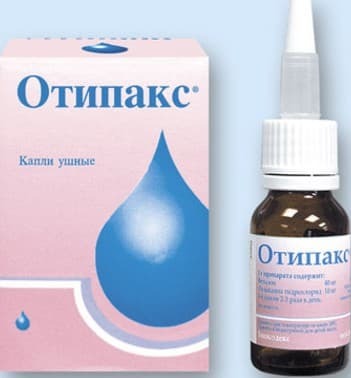
- OTF .These drops contain the antibiotic rifampicin, which acts on gram-positive and gram-negative bacteria. This makes Otofa practically a universal medicine, which perfectly helps with all forms of otitis. Another positive property of the drug is that it can be prescribed to children from the age of 3 even with a damaged eardrum. Burying Otof can be three times a day for 3 drops of children and 5 - adults. The treatment period should last no longer than a week - if this condition is not met, then the microorganisms become addicted to the active substance.

- Anauran .Glucocorticoid component of the drug has a local anesthetic and anti-inflammatory effect. The drug is prescribed in this dosage: 2-3 drops 3-4 times a day for children, adults with the same frequency should be instilled 4-5 drops. Duration of treatment - up to 7 days, but if necessary, taking the drug can be prolonged by the attending physician.
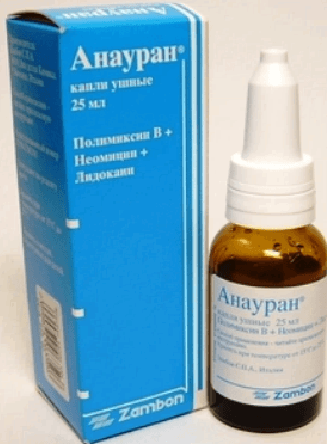
Regardless of the shape of the otitis at the first signs( pain), it is necessary to show the doctor as soon as possible to the doctor, who will prescribe the appropriate treatment after the examination. If the disease is started, it can lead to complications of varying severity: from the chronic form of the disease to purulent meningitis. This disease categorically does not accept amateur activity, since in the case of ineffective treatment in the middle ear can stagnate fluid with subsequent scar formation, and this is fraught with very long treatment and possible deterioration of hearing.
Under the link you will find signs of otitis in a child up to a year.
Treatment for Pregnancy
What if otitis has affected the ear during pregnancy? The first and main advice to all future moms is not to try to heal yourself, not to heat up your ear( this can lead to the multiplication of harmful bacteria that caused inflammation), do not use any drops without prescribing a doctor. The latter is particularly important, since practically all the currently existing drops are forbidden to use in an interesting situation. Complicating the situation is that pregnant women are contraindicated so necessary for inflammation of the ear vasoconstrictor drugs and antibiotics. What to do? At the first signs of otitis, immediately go to a doctor who will choose the treatment that is least threatening the health of the fetus. Most often in this situation, Otopix is prescribed - the only medicine that does not have severe contraindications during pregnancy. The complex of treatment can include physiotherapy methods.
The video tells about the use of ear drops in otitis:
Given the difficulties arising in the treatment of otitis in pregnant women, pregnant women need to take preventive measures. Since otitis is a complication after a cold and ARVI, avoid overcooling, places of congestion( especially during epidemic periods), eat foods rich in vitamins, avoid water ingress into ears, and exercise caution in the hygiene of the ear canals. If you can not avoid a cold, you can not run it in any case - the treatment prescribed by the doctor should be taken to the full and until the recovery is complete.
Procedure for instillation: sequence of actions of
In order for the treatment to be effective, the installation procedure should be carried out in such a sequence.
- Make sure that there is a sulfur plug in the ear - if it is available, most of the medicine will be absorbed by sulfur, as a result of which the plug will swell, the hearing will deteriorate. The ear will continue to ache, but there will be no therapeutic effect. This can be done only by an otolaryngologist who, if necessary, will immediately perform the procedure of washing the ear canal.
- Lay the patient on his side, opposite to the sick ear.
- Carry out superficial hygiene of the ear and auditory canal. The ear ear, as a rule, emits a lot of liquid and sulfur, which leads to its rapid contamination even in the absence of a plug. You can not use cotton buds for cleaning - it's painful and dangerous. Hygienic procedure should be carried out with a small piece of cotton wool, which if necessary can be slightly moistened in hydrogen peroxide( make sure that cold peroxide does not flow inward, for this, cotton should be well wrung out).
- Inject the number of drops in the ear. To avoid the occurrence of an airlock, after each drop, you need to massage the ear lobe lightly.
- Give patient to lie down in this position for about five minutes - during this period the drops penetrate deep enough and will not leak out when the patient takes a vertical position.
- It is compulsory to repeat manipulation with the second ear, even if it does not hurt, since the otitis has the property of "moving" from one hearing organ to another.
- The auricles after the procedure should not be covered with anything - blocking access to oxygen, we give the "green light" to the reproduction and spread of bacteria.
On the video - ear drops from otitis for people:
Summing up, I would like to once again focus readers' attention on such important issues as prevention of otitis and its timely diagnosis. The ear is an organ located very close to the brain. Therefore, delay in treatment can end very badly. If you go to the doctor on time, the treatment, as a rule, does not cause any difficulties and after a maximum of two or three days after visiting the doctor the pain will recede.
